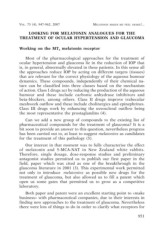Page 141 - 73_04
P. 141
VOL. 73 (4), 947-962, 2007 MELATONIN MAKES ME FEEL AWAKE!...
LOOKING FOR MELATONIN ANALOGUES FOR THE
TREATMENT OF OCULAR HYPERTENSION AND GLAUCOMA
Working on the MT3 melatonin receptor
Most of the pharmacological approaches for the treatment of
ocular hypertension and glaucoma lie in the reduction of IOP that
is, in general, abnormally elevated in these patients. In this sense all
the approaches reduce IOP by acting on different targets (tissues)
that are relevant for the correct physiology of the aqueous humour
dynamics. These compounds, independently of their chemical na-
ture can be classified into three classes based on the mechanism
of action. Class I drugs act by reducing the production of the aqueous
humour and these include carbonic anhydrase inhibitors and
beta-blockers, among others. Class II drugs improve trabecular
meshwork outflow and these include cholinergics and epinephrines.
Class III drugs work by enhancing the uveoscleral outflow being
the most representative the prostaglandins (4).
Can we add a new group of compounds to the existing list of
pharmaceutical compounds for the treatment of glaucoma? It is a
bit soon to provide an answer to this question, nevertheless progress
has been carried out to, at least to suggest melatonins as candidates
for the treatment of this pathology (5).
Our interest in that moment was to fully characterise the effect
of melatonin and 5-MCA-NAT in New Zealand white rabbits.
Therefore, single dosage, dose-response studies and preliminary
antagonist studies permitted us to publish our first paper in the
field, paper which was cited as one of the breakthrough in the
glaucoma literature in 2001 (3). This experimental work permitted
not only to introduce melatonins as possible new drugs for the
treatment of glaucoma, but also allowed us to fill a patent which
open us some gates that permitted us to grow as a competitive
laboratory.
Both paper and patent were an excellent starting point to «make
business» with pharmaceutical companies, due to their interests in
finding new approaches to the treatment of glaucoma. Nevertheless
there were lots of things to do in order to clarify what receptors for
951

